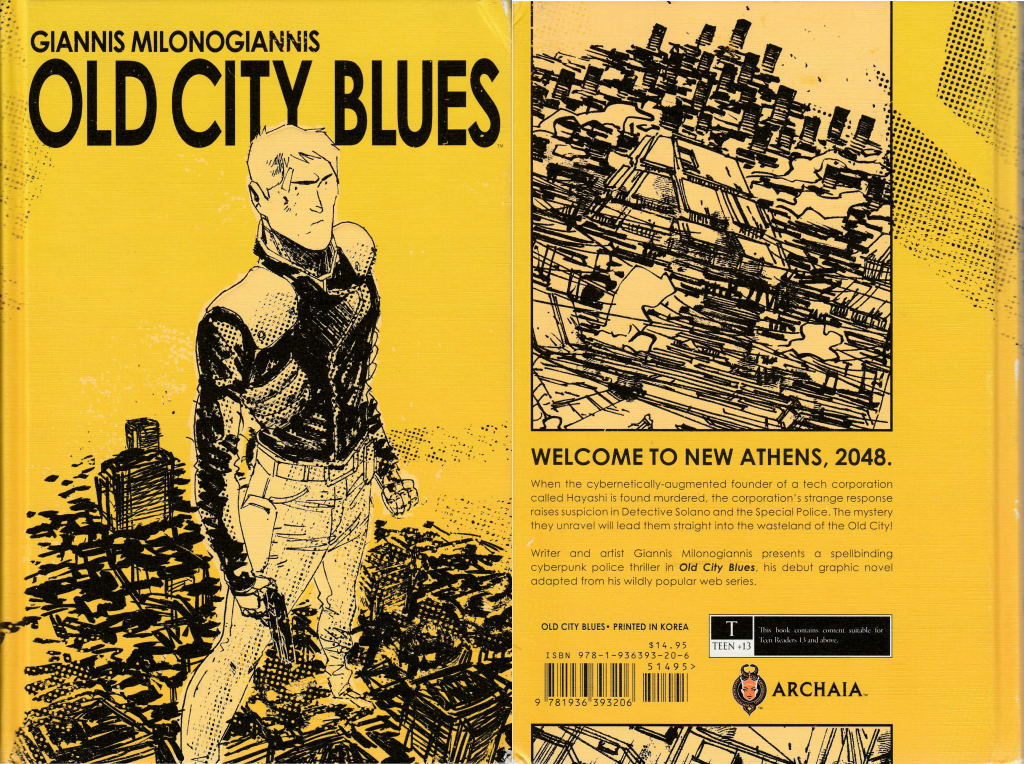





…starts with one step. In the “A Thousand Miles” series, I’ll be taking a series each week that looks interesting to me and reviewing the first volume. Focused on, essentially, exposing myself to as many new series as possible, each will culminate in whether I think it’s worth continuing.
****
Old City Blues is a Sci Fi crime thriller manga (?) by Giannis Milonogiannis. It started as an art sampler in 2009 and was shortly expanded thereafter into a webcomic in 2010. Reception was good and word eventually got around to Archaia who published the first volume in August 2011.

Giannis Milonogiannis – I don’t mean this as an indictment of the artist, but I doubt Giannis is a household name. In fact, this is their debut book. That being said, they aren’t completely unknown. Like stated earlier, OCB got its start as a webcomic. As such, you may have already seen their work on Tumblr (like yours truly) – especially if you frequented the site “pre-purge”.
Old City Blues The title uses no stylized logo. Combined with the hard cover, it has the air of a novel or technical book (presumably) from before my time. I can’t quite put my finger on what this conveys, but I can say that this book should be on the shelf next to Ghost in Shell and Blade Runner – an aspect undersold by this aesthetic .
Larger Than Life – The cover depicts our protagonist, Solano, as a giant standing in a city and a skyline shot of the city on the other side. Said city is 2048 Athens (referred to as “New Athens”) of which Solano is a part of its police force. We’ll talk more about New Athens later. The way Solano is positioned, he towers over the city, but not as a menace. His stance gives an air of confidence and challenge. It’s all a visual metaphor for how Solano abides over and protects New Athens.
Old City Blues centers around a rash of cyborg murders in New Athens. Solano, a member of the SDX (Special Police Division) is presently working the case. Things go from bad to worse when the founder of the Hayashi Corporation, one of the largest robotics companies in the world, Mr. Hayashi himself, is murdered. Solano and the SDX are scrambling to corner the murderer before they can strike again, but who exactly is this mystery killer and why are they targeting cyborgs?
Solano – SDX officer presently working the cyborg murder case. Serious and a tad surly, we’re unsure of how long he’s been on the force. But all things considered, he sure seems to fit the bill of a seasoned officer.
Chief Gortyn – SDX’s chief and, thus, Solano’s boss. He gives Solano his marching orders, but also advises him on not getting lost in the, at times, infuriating minutiae of the case.
Newberg – Mobile Gun Division pilot that came to work with Solano on the case. Newberg and Thermidor, his partner, have a “spirited” working relationship. They give each other crap, but usually it’s about staying sharp and avoiding trouble. They work well together when duty calls.
Thermidor – The other member of the Mobile Gun Division that works with Solano. She spends a bit more time with Solano and the two seem to have a less spastic, but effective nonetheless, relationship than the one she has with Newberg.
I said Old City Blues deserves to be on the shelf next to Ghost in the Shell and Blade Runner, but that’s not necessarily because of how well it emulates them. OCB feels like the kind of story that would’ve happened in the interim between today and GITS or Blade Runner’s universes, despite being set well after the events of them (2048 vs GITS’s 2024 and BR’s 2019). So what you get is a more grounded story, partly because we still have roughly 30 years to get anywhere close to this, but also because it doesn’t use its set up to ruminate on high minded philosophy. Instead, it elects to rely on the appeal of the characters and the spectacle of the case to be interesting. Of course, that means that OCB doesn’t get to be as “deep and philosophical” as the other two, but it also means that it makes for easy reading.
The thing that stands out the most is OCB’s distinctive art style. Anime, manga and graphic novels, by their very nature, are mediums whose strengths lie in their reliance on abstraction. OCB’s particular brand of stylization is a mix of thin line art for most foreground elements with, what I presume to be, thick and thin marker strokes for background elements and environments and liberal use of various grays for shading and lighting effects. It’s impressive how well it works. It’s a “more than the sum of its parts” affair as the individual strokes and marker lines can be picked out, but fuse together to make a convincing skyline or set of rooftops when you back out some….
…And that approach to art style sums up OCB as a whole. Honestly, I found myself at a lost for words in describing OCB, but also not having bad feelings towards it, either. I came to realize that this was because the individual elements (Thermidor and Solano, the cyberpunk setting, the art style) were alright by themselves, but come together to make for a smooth read. It’s a story about cops just trying their best to keep the peace in cyberpunk 2048 Athens.
And you know what? I’m totally all for that….
Continue?:



